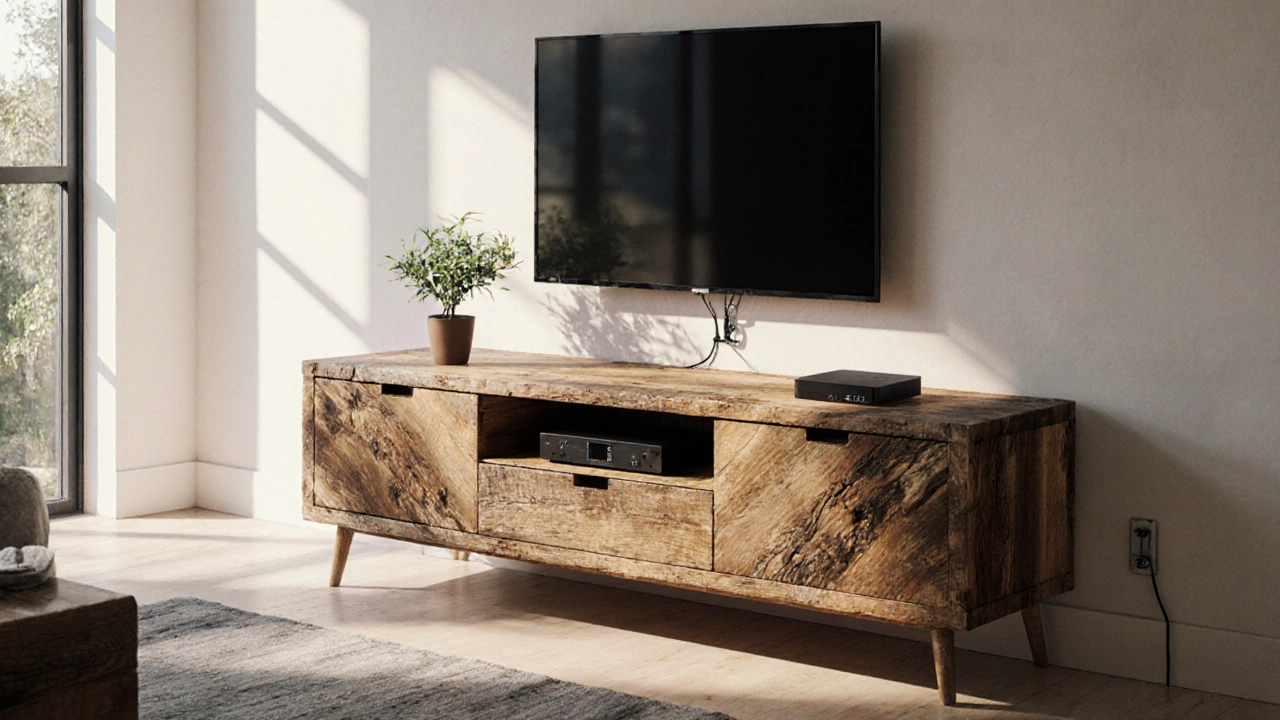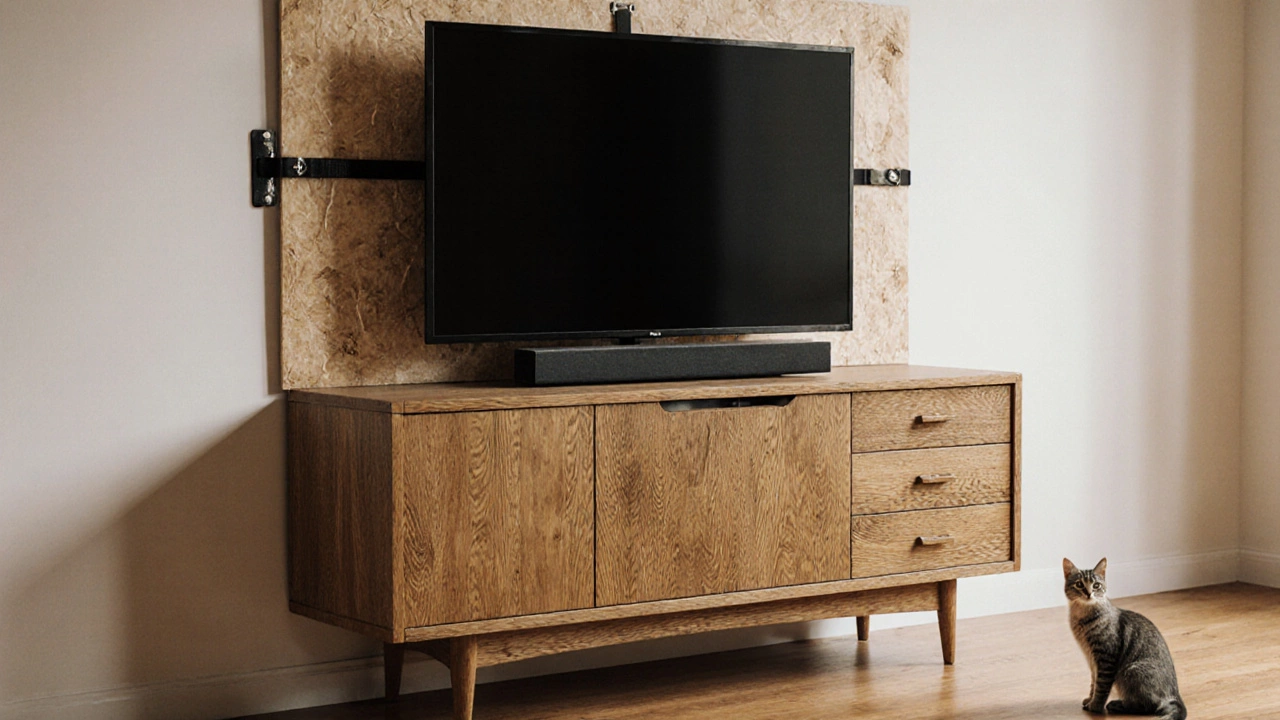Dresser Safety Calculator
Dresser Safety Calculator
Check if your dresser can safely support your TV based on dimensions, weight, and construction quality.
You’ve got a solid dresser sitting in your bedroom or spare room, and now you’re thinking-why not turn it into a TV stand? It’s sturdy, it has drawers, and it looks great. But before you plug in your 65-inch TV, you need to know if this is a smart move-or a safety risk.
Why People Try This
People swap dressers for TV stands for a few real reasons. Maybe your current stand is too small, too expensive, or just plain ugly. Maybe you found a vintage dresser at a thrift store for $50 and want to give it new life. Or maybe you’re in a rental and can’t buy new furniture. All of these are valid. But using a dresser as a TV stand isn’t just about style-it’s about structure, weight, and stability.Most dressers are built to hold clothes, not electronics. A typical 55- to 75-inch TV weighs between 40 and 80 pounds. Add a soundbar, cable box, game console, and a few streaming devices, and you’re pushing 100 pounds or more. That’s not a problem if the dresser is strong enough. But many modern dressers, especially flat-pack ones from big-box stores, aren’t.
Check the Dresser’s Build Quality
Not all dressers are created equal. You need to look at three things: material, construction, and width.Material matters. Solid wood dressers from the 1970s or 1980s? Those are usually fine. They’re thick, heavy, and built to last. Medium-density fiberboard (MDF) or particleboard? Those are risky. They crack under pressure, and screws strip out easily. If you can see exposed wood grain or feel the weight when you lift one corner, it’s likely solid. If it feels light and hollow, skip it.
Construction is key. Look at the joints. Are they dowelled, mortise-and-tenon, or glued and nailed? Those are strong. If the drawers just slide into slots with no real support, that’s a red flag. Also check the back panel. A thick, nailed-on plywood back adds rigidity. A thin paper or cardboard back? That’s just for show.
Width should match your TV. Your TV should sit flat, with at least 2 inches of clearance on each side. A 65-inch TV is about 57 inches wide. If your dresser top is only 50 inches wide, the TV will overhang. That’s not just ugly-it’s dangerous. A slight bump, a pet jumping up, or even a vacuum cleaner brushing the edge can tip it forward.
Weight Limits and Stability
Most dressers aren’t rated for weight like TV stands are. But you can estimate. A well-built solid wood dresser from a reputable brand can handle 150-200 pounds on the top surface. That’s enough for most TVs. But here’s the catch: it’s not just about the total weight-it’s about how it’s distributed.TV stands are designed with a low center of gravity. They’re wide, low, and often anchored to the wall. Dressers? They’re tall. They’re narrow. And they’re meant to be leaned against a wall, not loaded up on top.
Here’s a quick test: Place your TV on the dresser. Now, gently push the top edge of the TV with your hand. If the dresser wobbles, shifts, or leans back even slightly, it’s not safe. Even a 1/4-inch movement can cause the TV to tip over in an earthquake, during a child’s play, or if someone accidentally bumps into it.
The Consumer Product Safety Commission (CPSC) reports over 1,500 TV-related injuries each year in the U.S. alone. Most involve children under 6. A falling TV can kill. Don’t risk it.

How to Make It Safer
If you still want to use your dresser, here’s how to reduce the risk:- Anchor it to the wall. Use a TV anti-tip kit or furniture strap. Attach it to a wall stud-not just drywall. Even if the dresser feels stable now, earthquakes, pets, or clumsy kids can change that fast.
- Use a low-profile TV mount. Skip the bulky plastic stand that comes with the TV. Buy a slim, low-height mount that sits flush on the dresser top. This lowers the center of gravity and reduces leverage.
- Don’t overload the top. Keep only the TV and one or two small devices. No extra speakers, no stacked DVD players, no piles of cables. Every extra pound adds risk.
- Place the TV in the center. Make sure the TV is centered and doesn’t hang over the edge. Use a tape measure. Even 1 inch too far out can be dangerous.
- Check the drawers. Make sure the drawers open and close smoothly. If they stick, they can pull the dresser out of alignment. A misaligned dresser is unstable.
What You Should Avoid
Some dressers should never be used as TV stands-no matter how cute they look.- Tall, narrow dressers. Anything over 30 inches high and under 48 inches wide is a hazard.
- Modern flat-pack dressers. IKEA, Wayfair, Amazon Basics-these are made for light storage, not heavy electronics.
- Antique dressers with weak joints. Even beautiful old pieces can fall apart under weight. If the wood is cracked or the drawers rattle, don’t risk it.
- Dressers on carpet. Carpet doesn’t provide a flat, stable surface. Use a rug pad or place the dresser on a hard floor.

When to Just Buy a TV Stand
Sometimes, the cheapest option is to buy the right thing.A basic TV stand costs $50-$150. It’s designed for your TV. It has cable management, ventilation, and often includes wall anchors. It’s built to last. And if you’re renting, you can take it with you when you move.
Think about this: If your TV falls and breaks, you’re looking at $800-$2,000 in replacement cost. Add in a damaged wall, a broken sound system, or a child’s injury-and the savings from reusing a dresser disappear fast.
There’s no shame in buying the right tool for the job. A TV stand isn’t just furniture-it’s safety equipment.
Alternatives to Consider
If you love the look of a dresser but want safety and function, here are better options:- Media console with drawers. These are built like dressers but are wider, lower, and rated for TVs. Brands like Sauder, Hon, and Ameriwood offer solid options under $200.
- Reclaimed wood credenza. These are wide, heavy, and sturdy. Often found at flea markets or restoration shops. They’re made for heavy loads and look amazing.
- Custom-built shelf. Hire a carpenter to build a low, wide shelf with hidden storage. You get the look you want, with the strength you need.
Final Verdict
Yes, you can use a dresser as a TV stand-if it’s solid, wide, low, and anchored. But most people don’t check those boxes. If your dresser is from the 1980s, made of oak, and sits on a hardwood floor with a wall anchor? Go ahead. It’s a cool, unique setup.If it’s a new, lightweight, particleboard dresser from a big-box store? Don’t risk it. Your TV isn’t worth the danger.
The goal isn’t to save money. It’s to keep your family safe. A TV stand isn’t just furniture. It’s a piece of your home’s safety system. Treat it that way.
Can any dresser be used as a TV stand?
No. Only sturdy, wide, low dressers made of solid wood with strong construction are safe. Most modern dressers, especially flat-pack ones, are not designed to hold heavy electronics and can tip over.
How do I know if my dresser is strong enough?
Lift a corner-it should feel heavy. Check for solid wood joints, a thick plywood back, and no wobble when you push the top. The top surface should be at least 2 inches wider than your TV on each side. If it’s under 50 inches wide, avoid it for TVs over 50 inches.
Do I need to anchor the dresser to the wall?
Yes. Always. Even if the dresser feels stable, anchoring prevents tipping during earthquakes, accidental bumps, or if a child climbs on it. Use a wall anchor kit and attach it to a stud.
What’s the safest TV placement on a dresser?
Center the TV so no part overhangs the edge. Use a low-profile mount instead of the TV’s original stand. Keep only essential devices on top-no extra speakers or stacked boxes. Avoid placing it on carpet.
Is it cheaper to use a dresser than buy a TV stand?
Sometimes, yes-but only if you already own the dresser. If you have to buy one, a proper TV stand costs the same or less than a solid wood dresser. And it’s safer, designed for electronics, and often comes with cable management and wall anchors built in.

